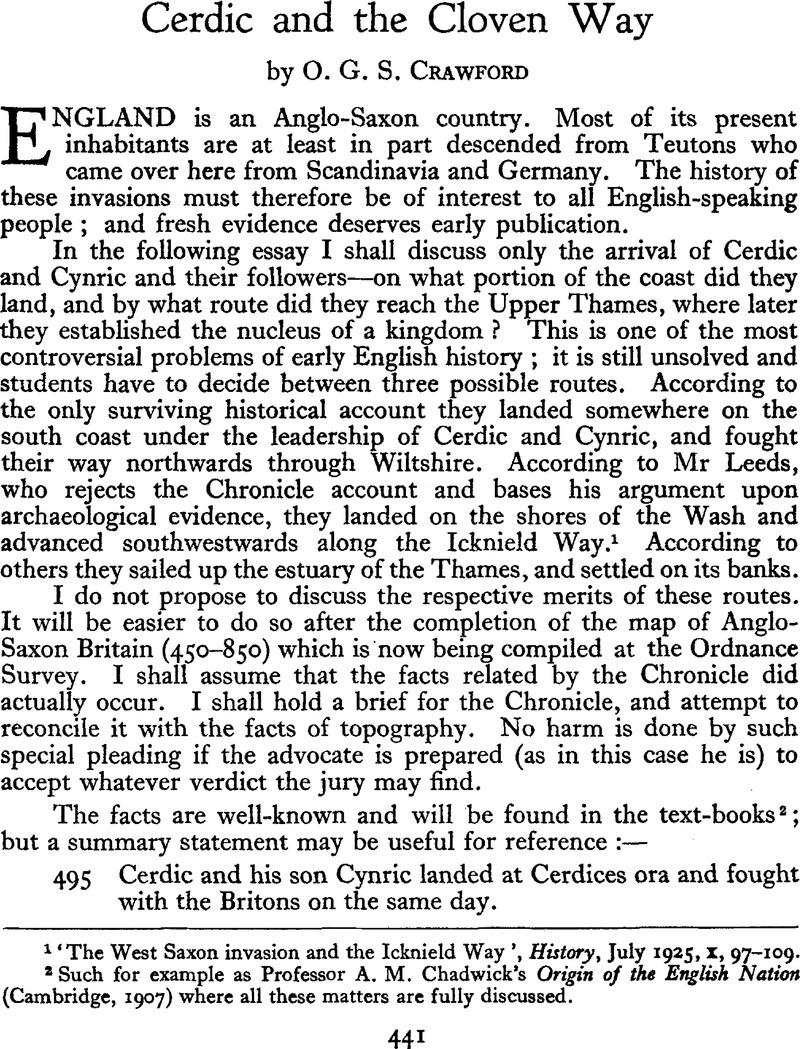Published online by Cambridge University Press: 02 January 2015

1 ‘The West Saxon invasion and the Icknield Way’, History, July 1925, 1, 97–109.Google Scholar
2 Such for example as Professor Chadwick’s, A.M. Origin of the English Nation (Cambridge, 1907)Google Scholar where all these matters are fully discussed.
3 Monumenta Historica Britannica (Record Commission, 1848), 503.Google Scholar
4 See note 1, at end, p. 457.
5 Early forms are :-Celces ora (980) : Calcheshourd (1340 ?): Calsherdes (1539): ‘Caldshore, communely Cawshot’ (Leland) : Calshord (State Papers, Eliz.). The suffix survives in Ower Lake, applied to the creek behind the shingle-spit. The name seems to mean ‘chalk shore’; referring perhaps to the place where chalk was disembarked for manuring the barren sandy and gravelly soil. Water-transport would be used for such heavy goods; there are sources near the sea at Portsdown (Paulsgrove) and Pan Down, Shide, Isle of Wight. Chalk is still used for marling at Nursling.
6 Early forms of Netley Marsh are Nateleg’ (1248), Natele (1256), Natale (1316), Natele (1327). Netley Marsh lies south of Tatchbury Mount and west of Bearslane End (see map, p. 456). Professor Mawer, to whom I am indebted for these forms, thinks that the name Netley (Marsh) ‘may well go back to OE Natan leah’. The present spelling may be due to the influence of Netley Abbey near, whose early forms (Letelie, Latalie) rule out identification with Natan leah. For Nettlebury see Sumner, Heywood, Earthworks of the New Forest, p. 96.Google Scholar
7 Archaeologia, 35, 259, 475.Google Scholar
8 Arch. Journ., 77, 112.Google Scholar
9 Bede, ch. IV, §16.
10 Florence of Worcester, ed. Thorpe, II, 44, 45. Stevenson, Asser, 168.
11 The confusion of Goths and Jutes is, according to Stevenson, purely a verbalone.
12 Ed. by Stevenson, p. 4.
13 Bk. III, ch. 7.
14 If the archaeological evidence is valid it follows that either the Chronicle dates must be wrong, or else its facts—and it was Saxons, not Britons, who were conquered in 571. I am not prepared to admit the validity of the archaeological evidence; I merely assume, for purposes of argument, that it may be correct.
15 Chadwick, Origin of the English Nation, chapter IV.
16 In DrFreeman’s, Williams Field Archaeology of Hampshire (Macmillan, 1915) there is published an extract from a letter of mine to the author, written immediately after its discovery : pp. 435–6.Google Scholar
17 ‘The Saxon battlefields of Wiltshire’, Arch.Journ. 75, 175–194.Google Scholar
18 See note 2 at end, p. 457.
19 This road is an old one, with a magnificent array of traffic-ruts accompanying it on the east, immediately north of its crossing of the Cloven Way. They can be seen in the open fields and heath north of the houses. Landford was suggested by Stevenson, W.H. (Asser's Life of Alfred, 1904, 319)Google Scholar as being probably the Leonaford where Asser stayed for 8 months with Alfred in his villa regia.
20 Since writing this I find that this western portion of the road has been briefly described by Mr Heywood Sumner, who also connects it with Cerdices ford. See DrFreeman’s, Williams Field Archaeology of Hampshire, 1915, 445.Google Scholar
21 See note 3, p. 458.
22 For a full description, with plan and sections and an account of its excavation, see Sumner, Heywood, Earthworks of Cranboune Chase, 1913, 57–62.Google Scholar
23 These objects are now in the Salisbury Museum, and I am indebted to Mr Frank Stevens, the Curator, and Mr Heywood Sumner for telling me about them.
24 Sumner, Heywood , New Forest, 1917, 86–7Google Scholar. Extracts (not published elsewhere) from Dr H. P. Blackmore’s note-book.
25 Archueologia, 35, 259, 475.Google Scholar
26 Close by is Ellendun where Egbert of Wessex defeated Beornwulf of Mercia in 823: see DrGrundy, in Arch. Journ. 75, 181–7Google Scholar, where the northward continuation of the same road is described.